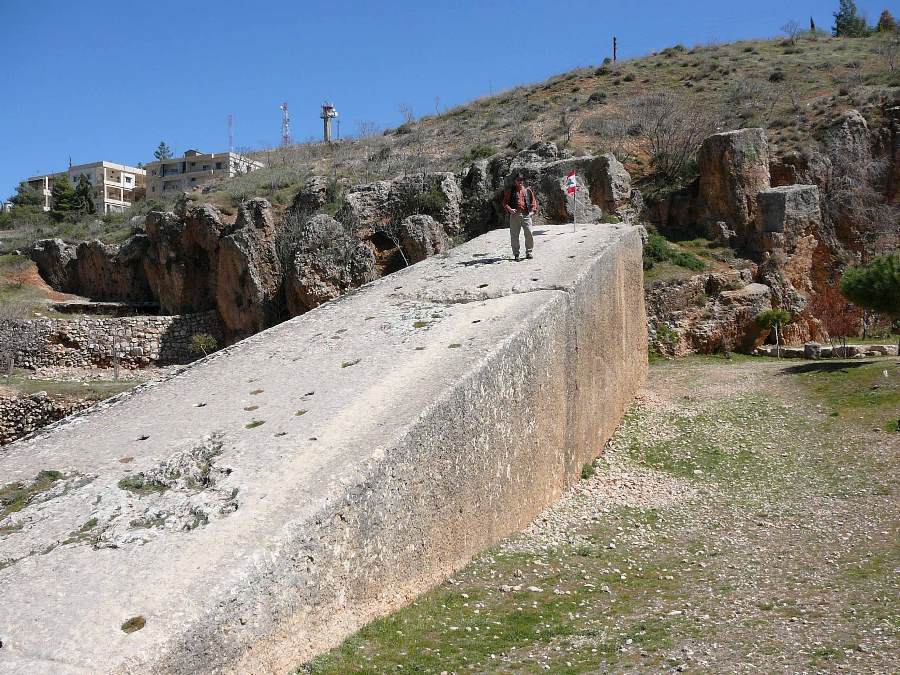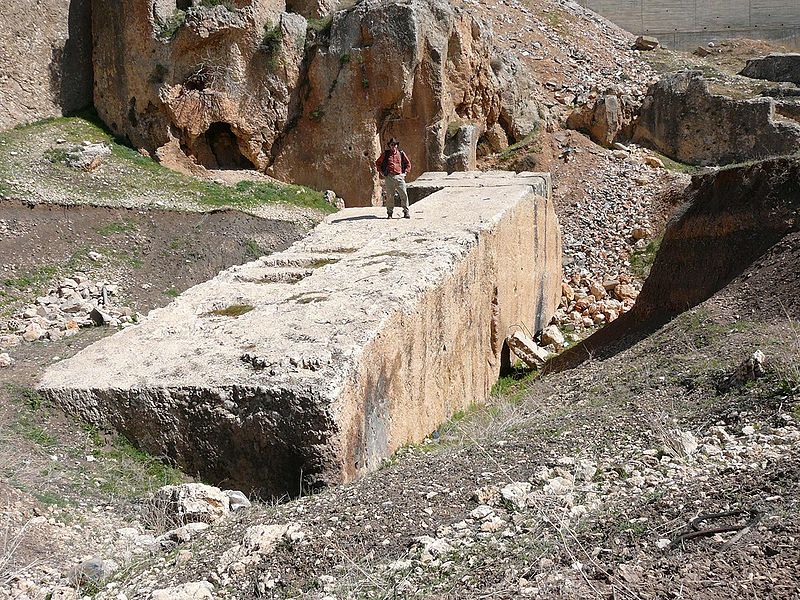|
|
|||
|
Baalbek, Lebanon Stone of the Pregnant Woman ..
Location 20.31–20.76 m long
Second
monolith
Name There are multiple stories behind the name. One
says the monolith is named after a pregnant woman
who tricked the naive people of Baalbek into
believing that she knew how to move the giant stone,
if only they would feed her until she gave birth.
Others say the name comes from the legends that
pregnant jinn were assigned the task of cutting and
moving the stone. While others say that the name
reflects the belief that a woman who touches the
stone will experience an increase in fertility. Third monolith A third ancient monolith was discovered in the
same quarry in 2014 by the Deutsches Archäologisches
Institut. Its weight is estimated at around 1650t,
making it the largest stone ever carved by human
hands.[11] It measures: |
|||
References:
|
|||
|
Archaeologists
Discover The World's Largest Ancient Stone
Block
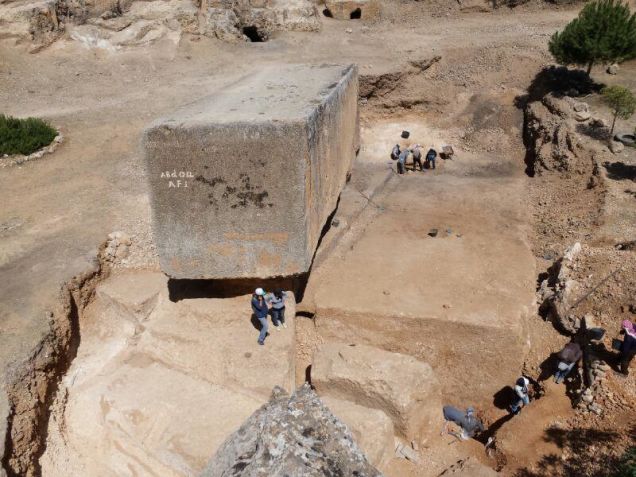 See that absurdly massive
stone block? Yeah, that's not the one we're
talking about. Look over to the right. German
archaeologists working at the Baalbek site in
Lebanon have uncovered the largest known ancient
block....
A few months ago, a team from the German Archaeological Institute conducted excavations at the quarry, and to their amazement they found an ever bigger stone just off to the side and underneath it. It measures 19.6 meters (64 feet) in length, 6 meters (19.6 feet) wide, and is at least 5.5 meters (18 feet) high. Its weight is estimated at a daunting 1,650 tons (that's 3,300,000 pounds, or 1,496,850 kg). Future excavations will confirm its precise dimensions. Archaeologists Discover The World's Largest Ancient Stone Block |
|||
|
Baalbek
- A Colossal Enigma
by Gian J. Quasara ~ From Biblioteca Pleyades This article introduces and
discusses new discoveries made in the colossal ruins
at Baalbek, Lebanon, and the possibility they are
evidence of a past super-civilization or, at least,
technically advanced civilization of “prehistory.”
Overview Baalbek is the name of an archeological site in Lebanon. In Roman times it was known as Heliopolis or City of the Sun. An example of how ancient is the site can be found in that its holiest area (in pagan times) was the Temple of Baal-Jupiter — a hybrid between the ancient Canaanite god Baal (lord) and the Roman Jupiter. Moreover, this temple was built on a “tel” or ruin mound, indicating a place that had long been held sacred, though what had caused this area to be significant or “sacred” is unknown. 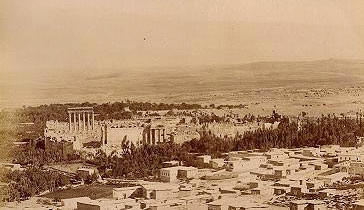 A panorama of ancient Baalbek, seen from a nearby hill. The ruins are the Roman temples of Bacchus (foreground) and Baal-Jupiter. Well, most date from Roman
times. They, however, followed the pattern of
building upon the “sacred” areas of cultures before
them. This is also evident at Palmyra where the
temple of Baal is also built upon a tel or ruin
mound. The original Canaanite temples could be 2,000
years older than the Roman remains left today.
The question is, had the Canaanites done what the Romans did? In other words, did they build upon the site as well? If so, what caused the site to be considered sacred to them? The oldest part of the ruins at Baalbek fit absolutely no known culture, and were originally employed for some mysterious purpose. 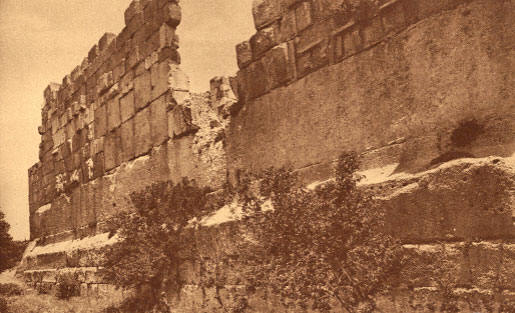 Back
of the temple of Baal-Jupiter. Smaller stones of
Roman date are haphazardly placed on top to form
a medieval fortress. At the bottom of the
picture, between the 2 trees, a man contemplates
their size. Can you see how small
he is compared?
Questions constantly crop up
concerning these blocks. Baalbek may become a focal
point for the dichotomy being uncovered throughout
the world today between the prehistoric past we
assume existed and our earliest cultures of history.
It is also a fact the Romans
did not use this type of stonework.The massive and elegant Roman stonework and columns pale by comparison to the megaliths they were built upon. The temple very visibly incorporates into its foundation, stones of some 1,500 tons. They are some 68 x 14 x 14 feet! They are the largest worked stones on earth! It is a mystery how such stones could have been moved into place, even according to our science and engineering knowledge of today. 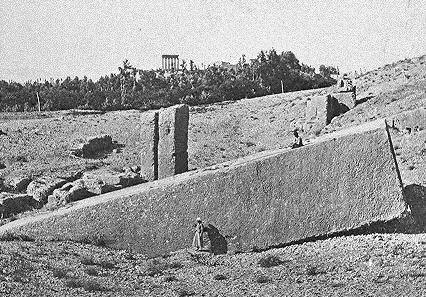 One
stone left in the quarry, undressed yet. They
are great, perfect rectangles.
This is a picture of the largest worked stone on earth. Some have estimated it to be 2,000 tons. To further increase their
mysterious origin and original use, these megaliths
are not “foundation stones” as they are always
declared. They represent the top course of stones of
the original edifice, whatever that may have been.
Whatever its purpose, it was essential that the
greatest stones had to be on top, not on the bottom.
The whole edifice is inverted in concept, fact and
layout.
Below them at least 3 tiers of stones can be found, much smaller though still monumental in size. Another example that they are separate to the Roman temple, is that while the Romans built the back of their temple wall flush with 3 of these stones, on one of the sides of the temple of Jupiter the perimeter clearly falls short of the width of the original megalithic structure, allowing a tier of megaliths to protrude obtrusively from the temple foundation— incongruous if they were simply foundation stones for the Roman temple. But it seems the Romans could not extend the building far enough to cover the layout of megaliths.  What
the original edifice must have looked like—a
massive platform
Another mystery is found in
the stone wall on the far or backside of the temple,
that side that is the most famous in pictures
because it shows the remarkable proportion of the
megaliths in contrast to other stones around them.
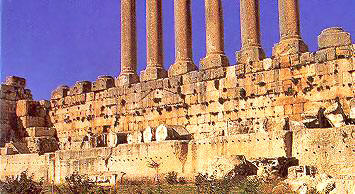 The
great stones continue on this side as well,
though their substructures are still buried.
The Roman temple falls far short of these
blocks, another indication they are not designed
for the temple but predate it considerably.
This wall is made up of many
ill-fitted stones, many of them reused from the
ruined Roman temple by the Arabs, Crusaders, and
Turks when the ruins were used as a fort. Some
pieces of the Roman entablature can be seen, as well
as slits cut into the rock for firing positions in
the wall.
Because all these stones are piled one upon the other, it is clear to see an evolution of stone working. This reveals some of the stones piled upon the megaliths to be even older than Roman. These are also huge stones. Yet despite their size, they are still dwarfed by the megalithic blocks.  Extraordinary
picture. This shows the famous backside of the
temple. The stones of the ruined Roman temple
were piled up to form a wall. There is even a
column base. But see the huge stones next to the
break in the wall.
They are as big as the Bimini stones and cut flush with the other, rather than neat squares. This architecture,
“Cyclopean,” is the oldest we know of, yet it
appears sloppy and small compared to the great
megaliths below them.
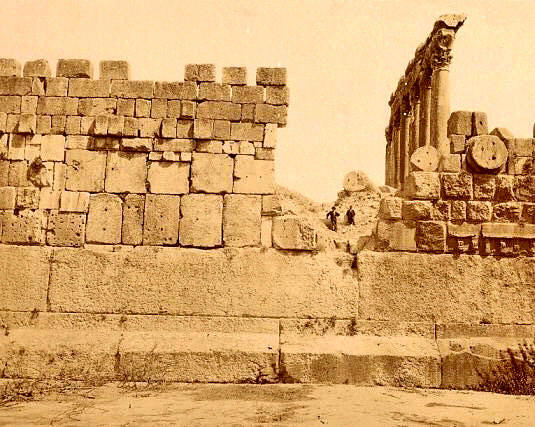 These
cyclopean stones are certainly not Roman. The
square cut Roman stones are heaped on top of
them by the Arabs or Crusaders, whoever turned
the ruins into a medieval fortress. Look at how
small the two men are compared to the cyclopean
stonework, let alone the megaliths upon which
they are built.
The Funerary Temple
of Kafre at Giza, 4th dynasty (about 2500 BC).
Similar to the stonework seen above, noteworthy for
economical cutting and fitting of imprecise angles
in the blocks, unlike the precision seen in great
megaliths here.
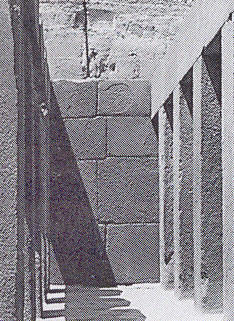 Left, the excavated walls
of Kafre’s (Chefren) temple. It stands in the
shadow of no less than the 2nd great pyramid at
Giza, Egypt. Even this very ancient monumental
wall seems later than the megaliths at Baalbek.
They match some of the unascribed stones built
thereon, however, possibly by later peoples or
early Canaanites. Left, the excavated walls
of Kafre’s (Chefren) temple. It stands in the
shadow of no less than the 2nd great pyramid at
Giza, Egypt. Even this very ancient monumental
wall seems later than the megaliths at Baalbek.
They match some of the unascribed stones built
thereon, however, possibly by later peoples or
early Canaanites.Their style is identical to the earliest cultures of monumental stone we know of like the Egyptian and the Pre-Incan Peru cultures, like those on Malta and, frankly, like those being encountered on the Bahamas Banks within the Triangle. Excavating deeper, the other great mystery was found. Perfectly cut, though smaller, stones were found. The megaliths were not designed as the foundation of the original building, but were meant to be the top. 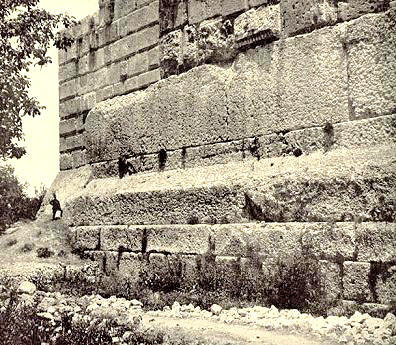 Why? What for? The stones of the Roman temple can be seen built behind and on top of them. This evolution in stonework is remarkable. From the small Roman and Turkish blocks, we go further down to monumental blocks identical with our earliest cultures. Yet lower than this, we come not to primitive mud bricks or shanty-hut foundations, but to the greatest stones worked by man. They are not clumsy artifacts, crude and compromised cuts like Stonehenge. They are perfectly fitted 1,500 ton stones forming a foundation not even a huge Roman temple could encompass. Our own science and engineering today cannot explain them, let alone what their function was. It would seem some unknown culture could move these great stones, place them on top of others, in perfect fit and alignment, before the dawn of our most ancient cultures. What caused them to pass away without leaving a clue as to who they were and to what purpose they built such a stupefying platform? SOURCE: Biblioteca Pleyades |
|||
| Baalbek
- Lebanon's Sacred Fortress by Andrew Collins ~ From Biblioteca Pleyades New Dawn Magazine No. 43 July-August 1997 from NewDawnMagazine Website Spanish version In the recent past the
tranquility of the Beqa’a Valley, that runs
north-south between the Lebanon and Ante-Lebanon
mountain ranges, has been regularly shattered by the
screeching noise of Israeli jet fighters.
Their targets are usually the Hizbullah training camps, mostly for reconnaissance purposes, but occasionally to drop bombs on the local inhabitants. It is a sign of the times in the troubled Middle East. Yet the Beqa’a Valley is also famous for quite another reason. Elevated above the lazy town of Baalbek is one of architecture’s greatest achievements. I refer to the almighty Temple of Jupiter, situated besides two smaller temples, one dedicated to Venus, the goddess of love, and the other dedicated to Bacchus, the god of fertility and good cheer (although some argue this temple was dedicated to Mercury, the winged god of communication). Today these wonders of the classical world remain as impressive ruins scattered across a wide area, but more remarkable still is the gigantic stone podiums within which these structures stand. An outer podium wall, popularly known as the ’Great Platform’, is seen by scholars as contemporary to the Roman temples. Yet incorporated into one of its courses are the three largest building blocks ever used in a man-made structure. Each one weighs an estimated 1000 tonnes a piece.(1) They sit side-by-side on the fifth level of a truly cyclopean wall located beyond the western limits of the Temple of Jupiter. Even more extraordinary is the fact that in a limestone quarry about one quarter of a mile away from the Baalbek complex is an even larger building block. Known as Hajar el Gouble, the Stone of the South, or the Hajar el Hibla, the Stone of the Pregnant Woman, it weighs an estimated 1200 tonnes.(2) It lays at a raised angle - the lowest part of its base still attached to the living rock - cut and ready to be broken free and transported to its presumed destination next to the Trilithon, the name given to the three great stones in ancient times. The enigma is this - although the high-tech, computer programmed jet fighters that scream through the Beqa’a Valley possess laser-guided missiles that can precision bomb to within three feet of their designated target, there is not a crane today that can even think of lifting a 1000-tonne weight, never mind a 1200-tonne weight like the stone block left in the quarry. Confounding the mystery even further is how the builders of the Trilithon managed to position these stones side by side with such precision that, according to some commentators not even a needle can be inserted between them.(3) So who were the supermen behind this breath-taking project? Surely the world is aware of their origins and history. Who were these people? Unfortunately, however, nobody knows their names. Nowhere in extant Roman records does it mention anything at all about the architects and engineers involved in the construction of the Great Platform. No contemporary Roman historian or scholar commentates on how it was constructed, and there are no tales that preserve the means by which the Roman builders achieved such marvelous feats of engineering. Why? Why the silence? Surely someone, somewhere, must know what happened. And herein the problems begin, for the local inhabitants of the Beqa’a Valley - who consist in the main of Arab Muslims, Maronite Christians and Orthodox Christians - do preserve legends about the origins of the Great Platform, but they do not involve the Romans. They say that Baalbek’s first city was built before the Great Flood by Cain, the son of Adam, whom God banished to the ’land of Nod’ that lay ’east of Eden’ for murdering his good brother Abel, and he called it after his son Enoch.(4) The citadel, they say, fell into ruins at the time of the deluge and was much later re-built by a race of giants under the command of Nimrod, the ’mighty hunter’ and ’king of Shinar’ of the Book of Genesis.(5) So, Who do we believe - the academics who are of the opinion that the Great Platform was constructed by the Romans, or the local folktales which ascribe Baalbek’s cyclopean masonry to a much earlier age? And if we are to accept the latter explanation, then who exactly were these ’giants’, gigantes or Titans of Greek tradition? Furthermore, why accredit Cain, Adam’s outcast son, as the builder of Baalbek’s first city? In an attempt to answer some of these questions it will be necessary to review the known history of Baalbek and to examine more closely the stones of the Trilithon in relationship to the rest of the ruins we see today. It will also be necessary to look at the mythologies, not only of the earliest peoples of Lebanon, but also the Hellenic Greeks. Only by doing this will a much clearer picture begin to emerge. |
|||
| Related Links:
|
|||
| FAIR USE NOTICE: This page contains copyrighted material the use of which has not been specifically authorized by the copyright owner. Pegasus Research Consortium distributes this material without profit to those who have expressed a prior interest in receiving the included information for research and educational purposes. We believe this constitutes a fair use of any such copyrighted material as provided for in 17 U.S.C § 107. If you wish to use copyrighted material from this site for purposes of your own that go beyond fair use, you must obtain permission from the copyright owner. | |||
|
|
